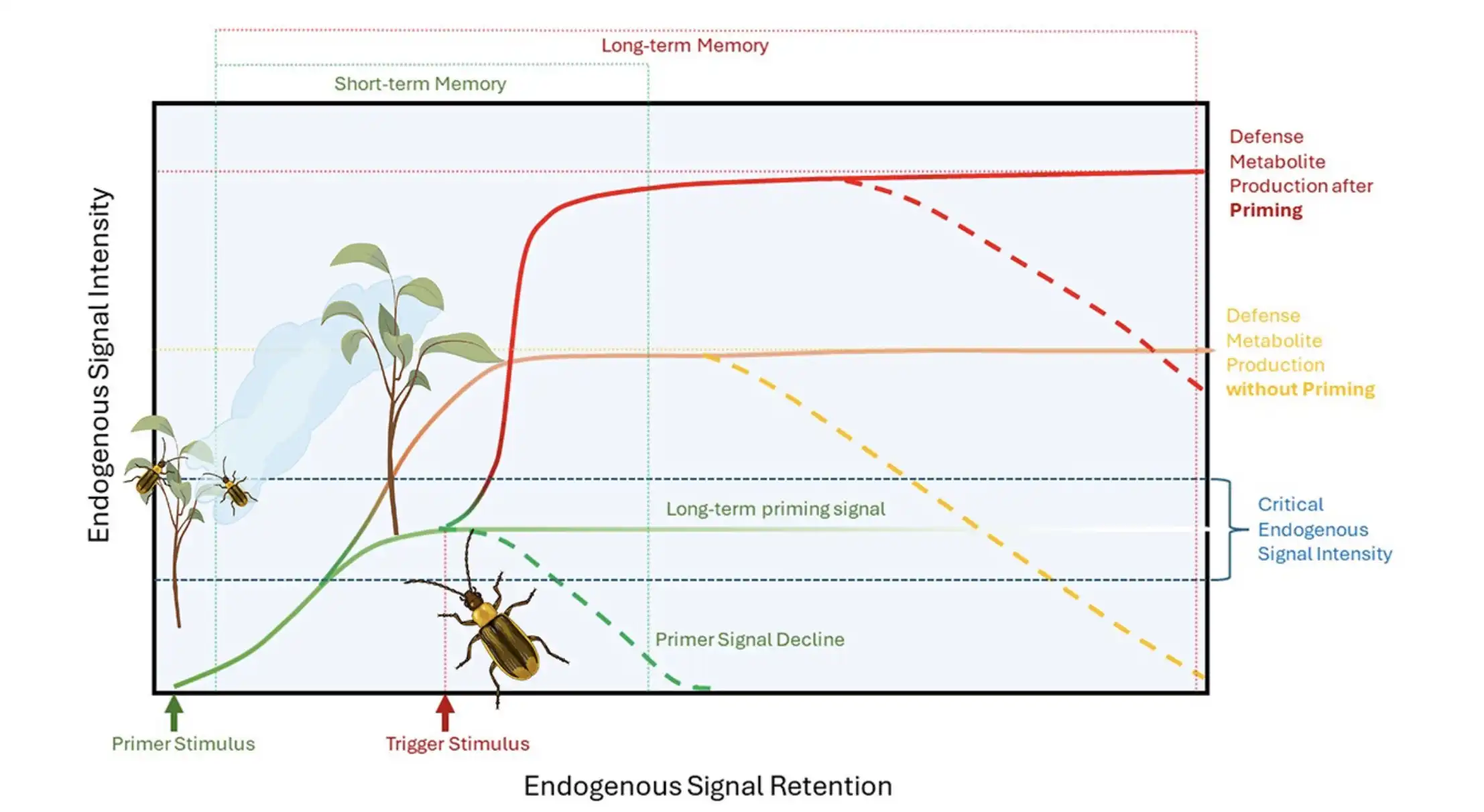Goldenrod can perceive other plants nearby without ever touching them, by sensing far-red light ratios reflected off leaves. When goldenrod is eaten by herbivores, it adapts its response based on whether or not another plant is nearby.
Is this kind of flexible, real-time, adaptive response a sign of intelligence in plants?
The question is not easy to answer, but Andre Kessler, a chemical ecologist, makes an argument for plant intelligence in a recent paper in the journal Plant Signaling & Behavior.
“There are more than 70 definitions that are published for intelligence and there is no agreement on what it is, even within a given field,” said Kessler, professor in the Cornell‘s Department of Ecology and Evolutionary Biology in the College of Agriculture and Life Sciences.
Many people believe that intelligence requires a central nervous system, with electrical signals acting as the medium for processing information. Some plant biologists equate plant vascular systems with central nervous systems, and propose that some kind of centralized entity in the plant allows them to process information and respond. But Kessler firmly disagrees with that idea.
“There is no good evidence for any of the homologies with the nervous system, even though we clearly see electrical signaling in plants, but the question is how important is that signaling for a plant’s ability to process environmental cues?” He said.
To make their argument for plant intelligence, Kessler and co-author Michael Mueller, a doctoral student in his lab, narrowed their definition down to the most basic elements: “The ability to solve problems, based on the information that you get from the environment, toward a particular goal,” Kessler said.
As a case study, Kessler points to his earlier research investigating goldenrod and its responses when eaten by pests. When leaf beetle larvae eat goldenrod leaves, the plant emits a chemical that informs the insect that the plant is damaged and is a poor source of food. These airborne chemicals, called volatile organic compounds (VOCs), are also picked up by neighboring goldenrod plants, prompting them to produce their own defenses against the beetle larvae. In this way, goldenrod move herbivores on to neighbors, and distribute damage.
In a 2022 paper in the journal Plants, Kessler and co-author Alexander Chautá, Ph.D. ’21, ran experiments to show that goldenrod can also perceive higher far-red light ratios reflected off leaves of neighboring plants. When neighbors are present and goldenrods are eaten by beetles, they invest more into tolerating the herbivore by growing faster yet also start producing defensive compounds that help the plants fight off insect pests. When no neighbors are present, the plants don’t resort to accelerated growth when eaten and the chemical responses to herbivores are markedly different, though they still tolerate quite high amounts of herbivory.
“This would fit our definition of intelligence,” Kessler said. “Depending on the information it receives from the environment, the plant changes its standard behavior.”
Neighboring goldenrod also exhibit intelligence when they perceive VOCs that signal the presence of a pest. “The volatile emission coming from a neighbor is predictive of future herbivory,” Kessler said. “They can use an environmental cue to predict a future situation, and then act on that.”
Applying the concept of intelligence to plants can inspire fresh hypotheses about the mechanisms and functions of plant chemical communication, while also shifting people’s thinking about what intelligence really means, Kessler said.
The latter idea is timely, as artificial intelligence is a current topic of interest. For example, he said, artificial intelligence doesn’t solve problems toward a goal, at least not yet. “Artificial intelligence, by our definition of intelligence, is not even intelligent,” he said. It is instead based on the patterns it identifies in information it can access.
An idea that interests Kessler came from mathematicians in the 1920s who proposed that perhaps plants functioned more like beehives. In this case, each cell operates like an individual bee, and the entire plant is analogous to a hive.
“What that means is, the brain in the plant is the entire plant without the need of central coordination,” Kessler said.
Instead of electrical signaling, there is chemical signaling throughout the superorganism. Studies by other researchers have shown that every plant cell has broad light spectrum perception and sensory molecules to detect very specific volatile compounds coming from neighboring plants.
“They can smell out their environment very precisely; every single cell can do it, as far as we know,” he said. Cells might be specialized, but they also all perceive the same things, and they communicate via chemical signaling to trigger a collective response in growth or metabolism. “That idea is very appealing to me,” he said.
The paper was supported by a grant from the New Phytologist Fund.
Read the paper: Plant Signaling & Behavior
Article source: Cornell University
Author: Krishna Ramanujan
Image: Plant defense priming in response to herbivory. Primer stimuli are environmental cues (e.g. volatile organic compounds from damaged neighboring plants, direct herbivore damage, spectral and chemical information) that elicit plant endogenous signaling and so ready plants for faster and stronger responses when additional attacks by herbivores occur (trigger stimulus). Intensity of the priming stimulus and the plant’s inherit sensitivity determine how strongly the plant is responding to a stimulus, reaching from alterations in endogenous signaling that may not significantly affect metabolism to a direct induction of defense metabolism. If the endogenous signal intensity elicit by environmental stimuli ranges within a critical signal intensity, a subsequent trigger stimulus (e.g. direct damage by a herbivore) will result in a faster and stronger expression of the plant defense metabolism. The reliability of a priming stimulus as a predictor of subsequent fitness-affecting damage will affect endogenous signal intensity and retention and thus if the priming information is stored in short- (e.g. transient, transcript and phytohormone accumulation) or long-term memory (e.g. epigenetic alterations). Defense priming allows the integration of environmental information to optimize plant responses while minimizing the costs associated with unreliable (false) environmental information. Credit: Plant Signaling & Behavior






